Chromosome-Level Genome Assembly and Annotation of the Highly Heterozygous Phallus echinovolvatus Provide New Insights into Its Genetics
Abstract
1. Introduction
2. Materials and Methods
2.1. Fungal Strain and Genome Sequencing
2.2. Genome Assembly and Assessment
2.3. Component Prediction
2.4. Gene Annotation
2.5. Comparative Genomics Analysis
3. Results and Discussions
3.1. Genome Sequencing and Assembly
3.2. Genome Component of P. echinovolvatus
3.2.1. Gene Prediction
3.2.2. Repeat Sequences Prediction
3.2.3. Non-Coding RNA Prediction
3.3. Annotation of Gene Function
3.3.1. GO Annotation
3.3.2. KEGG Annotation
3.3.3. KOG Annotation
3.3.4. The Cytochromes P450 (CYPs) Family
3.4. Comparative Genomics Analysis
3.4.1. CAZymes
3.4.2. Secondary Metabolites
3.4.3. Phylogenetic Analysis
3.4.4. Collinearity Analysis
3.4.5. Comparative Analysis of Hap1 and Hap2
4. Conclusions
Supplementary Materials
Author Contributions
Funding
Institutional Review Board Statement
Informed Consent Statement
Data Availability Statement
Acknowledgments
Conflicts of Interest
References
- Zhang, M.; Zheng, D.; Hu, Z. A new species of the Genus Dictyophora from China. Mycotaxon 1988, 33, 145–148. [Google Scholar]
- Melanda, G.C.S.; Silva-Filho, A.G.S.; Lenz, A.R.; Menolli, N.; de Lima, A.A., Jr.; Ferreira, R.J.; de Assis, N.M.; Cabral, T.S.; Martín, M.P.; Baseia, I.G. An overview of 24 years of molecular phylogenetic studies in Phallales (Basidiomycota) with notes on systematics, geographic distribution, lifestyle, and edibility. Front. Microbiol. 2021, 12, 689374. [Google Scholar] [CrossRef] [PubMed]
- Sommai, S.; Khamsuntorn, P.; Somrithipol, S.; Luangsa-Ard, J.J.; Pinruan, U. Phallus chiangmaiensis sp. Nov. and a record of P. merulinus in Thailand. Mycobiology 2021, 49, 439–453. [Google Scholar] [CrossRef] [PubMed]
- Kreisel, H. A preliminary survey of the genus Phallus sensu lato. Czech Mycol. 1996, 48, 273–281. [Google Scholar] [CrossRef]
- Cabral, T.S.; Marinho, P.; Goto, B.T.; Baseia, I.G. Abrachium, a new genus in the Clathraceae, and Itajahya reassessed. Mycotaxon 2012, 119, 419–429. [Google Scholar] [CrossRef]
- Moreno, G.; Khalid, A.N.; Alvarado, P.; Kreisel, H. Phallus hadriani and P. roseus from Pakistan. Mycotaxon 2013, 125, 45–51. [Google Scholar] [CrossRef]
- Li, H.; MORTIMER, E.E.; Karunarathna, S.C.; Xu, J.; Hyde, K.D. New species of Phallus from a subtropical forest in Xishuangbanna, China. Phytotaxa 2014, 163, 91–103. [Google Scholar] [CrossRef]
- Song, B.; Li, T.; Li, T.H.; Huang, Q.J.; Deng, W.Q. Phallus fuscoechinovolvatus (Phallaceae, Basidiomycota), a new species with a dark spinose volva from southern China. Phytotaxa 2018, 334, 19–27. [Google Scholar] [CrossRef]
- Læssøe, T.; Spooner, B. The uses of Gasteromycetes. Mycologist 1994, 8, 154–159. [Google Scholar] [CrossRef]
- Deng, C.; Shang, J.; Fu, H.; Chen, J.; Liu, H.; Chen, J. Mechanism of the immunostimulatory activity by a polysaccharide from Dictyophora indusiata. Int. J. Biol. Macromol. 2016, 91, 752–759. [Google Scholar] [CrossRef]
- Cheng, C.; Liu, F.; Wang, B.; Qu, P.; Liu, J.; Zhang, Y.; Liu, W.; Tong, Z.; Deng, G. Influences of Serendipita indica and Dictyophorae echinovolvata on the growth and fusarium wilt disease resistance of banana. Biology 2022, 11, 393. [Google Scholar] [CrossRef] [PubMed]
- Huang, M.; Tian, H.; Sun, B.; Liu, Y. Isolation and identification of oxacyclopentadecan-2-one from the dried fruiting body of Dictyophora echinovolvata Zang, Zheng et Hu. Flavour. Fragr. J. 2012, 27, 75–76. [Google Scholar] [CrossRef]
- Lin, C.; Zhang, H.; Chen, L.; Fang, Y.; Chen, J. Immunoregulatory function of Dictyophora echinovolvata spore polysaccharides in immunocompromised mice induced by cyclophosphamide. Open Life Sci. 2021, 16, 620–629. [Google Scholar] [CrossRef] [PubMed]
- Yu, W.X.; Lin, C.Q.; Zhao, Q.; Lin, X.J.; Dong, X.L. Neuroprotection against hydrogen peroxide-induced toxicity by Dictyophora echinovolvata polysaccharide via inhibiting the mitochondria-dependent apoptotic pathway. Biomed. Pharmacother. 2017, 88, 569–573. [Google Scholar] [CrossRef]
- Gao, Q.; Yan, D.; Song, S.; Fan, Y.; Wang, S.; Liu, Y.; Huang, Y.; Rong, C.; Guo, Y.; Zhao, S.; et al. Haplotype-resolved genome analyses reveal genetically distinct nuclei within a commercial cultivar of Lentinula edodes. J. Fungi 2022, 8, 167. [Google Scholar] [CrossRef]
- Park, Y.J.; Baek, J.H.; Lee, S.; Kim, C.; Rhee, H.; Kim, H.; Seo, J.S.; Park, H.R.; Yoon, D.E.; Nam, J.Y.; et al. Whole genome and global gene expression analyses of the model Mmushroom Flammulina velutipes reveal a high capacity for lignocellulose degradation. PLoS ONE 2014, 9, e93560. [Google Scholar]
- Fang, M.; Wang, X.; Chen, Y.; Wang, P.; Lu, L.; Lu, J.; Yao, F.; Zhang, Y. Genome sequence analysis of Auricularia heimuer combined with genetic Linkage Map. J. Fungi 2020, 6, 37. [Google Scholar] [CrossRef]
- Liu, W.; Chen, L.; Cai, Y.; Zhang, Q.; Bian, Y. Opposite polarity monospore genome de novo sequencing and comparative analysis reveal the possible heterothallic life cycle of Morchella importuna. Int. J. Mol. Sci. 2018, 19, 2525. [Google Scholar] [CrossRef]
- Morin, E.; Kohler, A.; Baker, A.R.; Foulongne-Oriol, M.; Lombard, V.; Nagy, L.G.; Ohm, R.A.; Patyshakuliyeva, A.; Brun, A.; Aerts, A.L.; et al. Genome sequence of the button mushroom Agaricus bisporus reveals mechanisms governing adaptation to a humic-rich ecological niche. Proc. Natl. Acad. Sci. USA 2012, 109, 17501–17506. [Google Scholar] [CrossRef]
- Duan, M.; Long, S.; Wu, X.; Feng, B.; Qin, S.; Li, Y.; Li, X.; Li, C.; Zhao, C.; Wang, L.; et al. Genome, transcriptome, and metabolome analyses provide new insights into the resource development in an edible fungus Dictyophora indusiata. Front. Microbiol. 2023, 14, 1137159. [Google Scholar] [CrossRef]
- Ma, L.; Yang, C.; Xiao, D.; Liu, X.; Jiang, X.; Lin, H.; Ying, Z.; Lin, Y. Chromosome-level assembly of Dictyophora rubrovolvata genome using third-generation DNA sequencing and Hi-C analysis. G3 2023, 13, jkad102. [Google Scholar] [CrossRef] [PubMed]
- Wang, J.; Tian, H.; Xu, Y.; Peng, X.; Zhang, C.; Lu, M.; Lu, Z.; Xu, S.; Wen, T.; Yang, C. Comprehensive analysis of the metabolome and the whole genome transcriptome to reveal the regulatory mechanism the flavor of Phallus rubrovolvatus. Food Biosci. 2024, 60, 104483. [Google Scholar] [CrossRef]
- Cheng, H.; Jarvis, E.D.; Fedrigo, O.; Koepfli, K.-P.; Urban, L.; Gemmell, N.J.; Li, H. Haplotype-resolved assembly of diploid genomes without parental data. Nat. Biotechnol. 2022, 40, 1332–1335. [Google Scholar] [CrossRef] [PubMed]
- Vollger, M.R.; Logsdon, G.A.; Audano, P.A.; Sulovari, A.; Porubsky, D.; Peluso, P.; Wenger, A.M.; Concepcion, G.T.; Kronenberg, Z.N.; Munson, K.M.; et al. Improved assembly and variant detection of a haploid human genome using single-molecule, high-fidelity long reads. Ann. Hum. Genet. 2020, 84, 125–140. [Google Scholar] [CrossRef] [PubMed]
- Zeng, Q.; Zhou, Z.; He, Q.; Li, L.; Pu, F.; Yan, M.; Xu, P. Chromosome-level haplotype-resolved genome assembly for Takifugu ocellatus using PacBio and Hi-C technologies. Sci. Data 2023, 10, 22. [Google Scholar] [CrossRef] [PubMed]
- Yi, L.; Sa, R.; Zhao, S.; Zhang, X.; Lu, X.; Mu, Y.; Bateer, S.; Su, S.; Wang, S.; Li, Z.; et al. Chromosome-scale, haplotype-resolved genome assembly of Suaeda glauca. Front. Genet. 2022, 13, 884081. [Google Scholar] [CrossRef]
- Han, L.; Luo, X.; Zhao, Y.; Li, N.; Xu, Y.; Ma, K. A haplotype-resolved genome provides insight into allele-specific expression in wild walnut (Juglans regia L.). Sci. Data 2024, 11, 278. [Google Scholar] [CrossRef]
- Sun, X.; Jiao, C.; Schwaninger, H.; Chao, C.T.; Ma, Y.; Duan, N.; Khan, A.; Ban, S.; Xu, K.; Cheng, L.; et al. Phased diploid genome assemblies and pan-genomes provide insights into the genetic history of apple domestication. Nat. Genet. 2020, 52, 1423–1432. [Google Scholar] [CrossRef]
- Duan, H.; Jones, A.W.; Hewitt, T.; Mackenzie, A.; Hu, Y.; Sharp, A.; Lewis, D.; Mago, R.; Upadhyaya, N.M.; Rathjen, J.P.; et al. Identification and correction of phase switches with Hi-C data in the Nanopore and HiFi chromosome-scale assemblies of the dikaryotic leaf rust fungus Puccinia triticina. bioRxiv 2021. [Google Scholar] [CrossRef]
- Liang, J.; Li, Y.; Dodds, P.N.; Figueroa, M.; Sperschneider, J.; Han, S.; Tsui, C.K.M.; Zhang, K.; Li, L.; Ma, Z.; et al. Haplotype-phased and chromosome-level genome assembly of Puccinia polysora, a giga-scale fungal pathogen causing southern corn rust. Mol. Ecol. Resour. 2023, 23, 601–620. [Google Scholar] [CrossRef]
- Bolger, A.M.; Lohse, M.; Usadel, B. Trimmomatic: A flexible trimmer for Illumina sequence data. Bioinformatics 2014, 30, 2114–2120. [Google Scholar] [CrossRef] [PubMed]
- Wingett, S.W.; Andrews, S. FastQ Screen: A tool for multi-genome mapping and quality control. F1000Research 2018, 7, 1338. [Google Scholar] [CrossRef] [PubMed]
- Cheng, H.; Concepcion, G.T.; Feng, X.; Zhang, H.; Li, H. Haplotype-resolved de novo assembly using phased assembly graphs with hifiasm. Nat. Methods 2021, 18, 170–175. [Google Scholar] [CrossRef] [PubMed]
- Zhang, X.; Zhang, S.; Zhao, Q.; Ming, R.; Tang, H. Assembly of allele-aware, chromosomal-scale autopolyploid genomes based on Hi-C data. Nat. Plants 2019, 5, 833–845. [Google Scholar] [CrossRef]
- Burton, J.N.; Adey, A.; Patwardhan, R.P.; Qiu, R.; Kitzman, J.O.; Shendure, J. Chromosome-scale scaffolding of de novo genome assemblies based on chromatin interactions. Nat. Biotechnol. 2013, 31, 1119–1125. [Google Scholar] [CrossRef]
- Lieberman-Aiden, E.; van Berkum, N.L.; Williams, L.; Imakaev, M.; Ragoczy, T.; Telling, A.; Amit, I.; Lajoie, B.R.; Sabo, P.J.; Dorschner, M.O.; et al. Comprehensive mapping of long-range interactions reveals folding principles of the human genome. Science 2009, 326, 289–293. [Google Scholar] [CrossRef]
- Simao, F.A.; Waterhouse, R.M.; Ioannidis, P.; Kriventseva, E.V.; Zdobnov, E.M. BUSCO: Assessing genome assembly and annotation completeness with single-copy orthologs. Bioinformatics 2015, 31, 3210–3212. [Google Scholar] [CrossRef]
- Hoff, K.J.; Stanke, M. WebAUGUSTUS-a web service for training AUGUSTUS and predicting genes in eukaryotes. Nucleic Acids Res. 2013, 41, W123–W128. [Google Scholar] [CrossRef]
- Birney, E.; Clamp, M.; Durbin, R. GeneWise and Genomewise. Genome Res. 2004, 14, 988–995. [Google Scholar] [CrossRef]
- Haas, B.J.; Salzberg, S.L.; Zhu, W.; Pertea, M.; Allen, J.E.; Orvis, J.; White, O.; Buell, C.R.; Wortman, J.R. Automated eukaryotic gene structure annotation using EVidenceModeler and the program to assemble spliced alignments. Genome Biol. 2008, 9, r7. [Google Scholar] [CrossRef]
- Tarailo-Graovac, M.; Chen, N. Using RepeatMasker to identify repetitive elements in genomic sequences. Curr. Protoc. Bioinform. 2009, 4, 4.10.11–14.10.14. [Google Scholar] [CrossRef] [PubMed]
- Lowe, T.M.; Eddy, S.R. tRNAscan-SE: A program for improved detection of transfer RNA genes in genomic sequence. Nucleic Acids Res. 1997, 25, 955–964. [Google Scholar] [CrossRef] [PubMed]
- Lagesen, K.; Hallin, P.; Rodland, E.A.; Stærfeldt, H.-H.; Rognes, T.; Ussery, D.W. RNAmmer: Consistent and rapid annotation of ribosomal RNA genes. Nucleic Acids Res. 2007, 35, 3100–3108. [Google Scholar] [CrossRef] [PubMed]
- Griffiths-Jones, S.; Moxon, S.; Marshall, M.; Khanna, A.; Eddy, S.R.; Bateman, A. Rfam: Annotating non-coding RNAs in complete genomes. Nucleic Acids Res. 2005, 33, D121–D124. [Google Scholar] [CrossRef]
- Chen, W.; Lee, M.-K.; Jefcoate, C.; Kim, S.-C.; Chen, F.; Yu, J.-H. Fungal Cytochrome P450 Monooxygenases: Their distribution, structure, functions, family expansion, and evolutionary origin. Genome Biol. Evol. 2014, 6, 1620–1634. [Google Scholar] [CrossRef]
- Zheng, J.; Ge, Q.; Yan, Y.; Zhang, X.; Huang, L.; Yin, Y. dbCAN3: Automated carbohydrate-active enzyme and substrate annotation. Nucleic Acids Res. 2023, 51, W115–W121. [Google Scholar] [CrossRef]
- Blin, K.; Shaw, S.; Augustijn, H.E.; Reitz, Z.L.; Biermann, F.; Alanjary, M.; Fetter, A.; Terlouw, B.R.; Metcalf, W.W.; Helfrich, E.J.N.; et al. antiSMASH 7.0: New and improved predictions for detection, regulation, chemical structures and visualisation. Nucleic Acids Res. 2023, 51, W46–W50. [Google Scholar] [CrossRef]
- Emms, D.M.; Kelly, S. OrthoFinder: Phylogenetic orthology inference for comparative genomics. Genome Biol. 2019, 20, 238. [Google Scholar] [CrossRef]
- Edgar, R.C. MUSCLE: Multiple sequence alignment with high accuracy and high throughput. Nucleic Acids Res. 2004, 32, 1792–1797. [Google Scholar] [CrossRef]
- Castresana, J. Selection of conserved blocks from multiple alignments for their use in phylogenetic analysis. Mol. Biol. Evol. 2000, 17, 540–552. [Google Scholar] [CrossRef]
- Darriba, D.; Taboada, G.L.; Doallo, R.; Posada, D. jModelTest 2: More models, new heuristics and parallel computing. Nat. Methods 2012, 9, 772. [Google Scholar] [CrossRef] [PubMed]
- Guindon, S.; Dufayard, J.-F.; Lefort, V.; Anisimova, M.; Hordijk, W.; Gascuel, O. New algorithms and methods to estimate maximum-likelihood phylogenies: Assessing the performance of PhyML 3.0. Syst. Biol. 2010, 59, 307–321. [Google Scholar] [CrossRef] [PubMed]
- Chen, C.; Wu, Y.; Li, J.; Wang, X.; Zeng, Z.; Xu, J.; Liu, Y.; Feng, J.; Chen, H.; He, Y.; et al. TBtools-II: A “one for all, all for one” bioinformatics platform for biological big-data mining. Mol. Plant. 2023, 16, 1733–1742. [Google Scholar] [CrossRef]
- Wöstemeyer, J.; Kreibich, A. Repetitive DNA elements in fungi (Mycota): Impact on genomic architecture and evolution. Curr. Genet. 2002, 41, 189–198. [Google Scholar] [CrossRef]
- Biscotti, M.A.; Olmo, E.; Heslop-Harrison, J.S. Repetitive DNA in eukaryotic genomes. Chromosome Res. 2015, 23, 415–420. [Google Scholar] [CrossRef]
- Plohl, M.; Luchetti, A.; Mestrovic, N.; Mantovani, B. Satellite DNAs between selfishness and functionality: Structure, genomics and evolution of tandem repeats in centromeric (hetero)chromatin. Gene 2008, 409, 72–82. [Google Scholar] [CrossRef]
- Cresnar, B.; Petric, S. Cytochrome P450 enzymes in the fungal kingdom. Biochim. Biophys. Acta 2011, 1814, 29–35. [Google Scholar] [CrossRef]
- Guengerich, F.P. Cytochrome P450s and other enzymes in drug metabolism and toxicity. AAPS J. 2006, 8, E101–E111. [Google Scholar] [CrossRef]
- Nelson, D.R. The Cytochrome p450 homepage. Hum. Genom. 2009, 4, 59–65. [Google Scholar] [CrossRef]
- Lombard, V.; Ramulu, H.G.; Drula, E.; Coutinho, P.M.; Henrissat, B. The carbohydrate-active enzymes database (CAZy) in 2013. Nucleic Acids Res. 2014, 42, D490–D495. [Google Scholar] [CrossRef]
- Payne, C.M.; Knott, B.C.; Mayes, H.B.; Hansson, H.; Himmel, M.E.; Sandgren, M.; Ståhlberg, J.; Beckham, G.T. Fungal cellulases. Chem. Rev. 2015, 115, 1308–1448. [Google Scholar] [CrossRef] [PubMed]
- Ha, J.W.; Kim, J.; Kim, H.; Jang, W.; Kim, K.H. Mushrooms: An important source of natural bioactive compounds. Nat. Prod. Sci. 2020, 26, 118–131. [Google Scholar] [CrossRef]
- Taofiq, O.; Martins, A.; Barreiro, M.F.; Ferreira, I.C.F.R. Anti-inflammatory potential of mushroom extracts and isolated metabolites. Trends Food Sci. Technol. 2016, 50, 193–210. [Google Scholar] [CrossRef]
- Robertsen, H.L.; Musiol-Kroll, E.M. Actinomycete-derived polyketides as a source of antibiotics and lead structures for the development of new antimicrobial drugs. Antibiotics 2019, 8, 157. [Google Scholar] [CrossRef]
- Roskova, Z.; Skarohlid, R.; McGachy, L. Siderophores: An alternative bioremediation strategy? Sci. Total Environ. 2022, 819, 153144. [Google Scholar] [CrossRef]
- Bozhüyük, K.A.J.; Präve, L.; Kegler, C.; Schenk, L.; Kaiser, S.; Schelhas, C.; Shi, Y.N.; Kuttenlochner, W.; Schreiber, M.; Kandler, J.; et al. Evolution-inspired engineering of nonribosomal peptide synthetases. Science 2024, 383, eadg4320. [Google Scholar] [CrossRef]
- Hai, Y.; Jenner, M.; Tang, Y. Fungal siderophore biosynthesis catalysed by an iterative nonribosomal peptide synthetase. Chem. Sci. 2020, 11, 11525–11530. [Google Scholar] [CrossRef]
- Ou, Y.X.; Li, Y.Y.; Qian, X.M.; Shen, Y.M. Guanacastane-type diterpenoids from Coprinus radians. Phytochemistry 2012, 78, 190–196. [Google Scholar] [CrossRef]
- Wang, X.L.; Ding, Z.Y.; Liu, G.Q.; Yang, H.; Zhou, G.Y. Improved production and antitumor properties of triterpene acids from submerged culture of Ganoderma lingzhi. Molecules 2016, 21, 1395. [Google Scholar] [CrossRef]
- Plett, J.M.; Wojtalewicz, D.; Plett, K.L.; Collin, S.; Kohler, A.; Jacob, C.; Martin, F. Sesquiterpenes of the ectomycorrhizal fungus Pisolithus microcarpus alter root growth and promote host colonization. Mycorrhiza 2024, 34, 69–84. [Google Scholar] [CrossRef]
- Li, H.P.; Yang, W.J.; Qu, S.X.; Pei, F.; Luo, X.; Mariga, A.M.; Ma, L. Variation of volatile terpenes in the edible fungi mycelia Flammulina velutipes and communications in fungus-mite interactions. Food Res. Int. 2018, 103, 150–155. [Google Scholar] [CrossRef] [PubMed]
- Sidorova, D.E.; Plyuta, V.A.; Padiy, D.A.; Kupriyanova, E.V.; Roshina, N.V.; Koksharova, O.A.; Khmel, I.A. The effect of volatile organic compounds on different organisms: Agrobacteria, plants and insects. Microorganisms 2021, 10, 69. [Google Scholar] [CrossRef] [PubMed]
- Sun, Y.; Xiang, Z.; Luo, Q.; Li, L.; Liu, N.; Tang, J.; Zhang, H.; Pan, G.; Long, H.; Zou, F. Analysis of volatile components and flavor characteristics about different temperature varieties of Dictyophora duplicata. Biotechnology 2019, 29, 586–592. [Google Scholar]
- Zheng, j.; Li, T.T.; Song, J.X.; Kan, J.Q. Analysis of Volatile Compounds in Embryo of Dictyophora indusiata (Vent. Pers.) Fisch Using Headspace-Solid Phase Microextraction Combined with GC-MS. Food Sci. 2014, 35, 125–128. [Google Scholar]
- Pu, X.; Dong, X.; Li, Q.; Chen, Z.; Liu, L. An update on the function and regulation of methylerythritol phosphate and mevalonate pathways and their evolutionary dynamics. J. Integr. Plant Biol. 2021, 63, 1211–1226. [Google Scholar] [CrossRef]
- Shi, L.; Ren, A.; Mu, D.; Zhao, M. Current progress in the study on biosynthesis and regulation of ganoderic acids. Appl. Microbiol. Biotechnol. 2010, 88, 1243–1251. [Google Scholar] [CrossRef]
- Wellenreuther, M.; Merot, C.; Berdan, E.; Bernatchez, L. Going beyond SNPs: The role of structural genomic variants in adaptive evolution and species diversification. Mol. Ecol. 2019, 28, 1203–1209. [Google Scholar] [CrossRef]

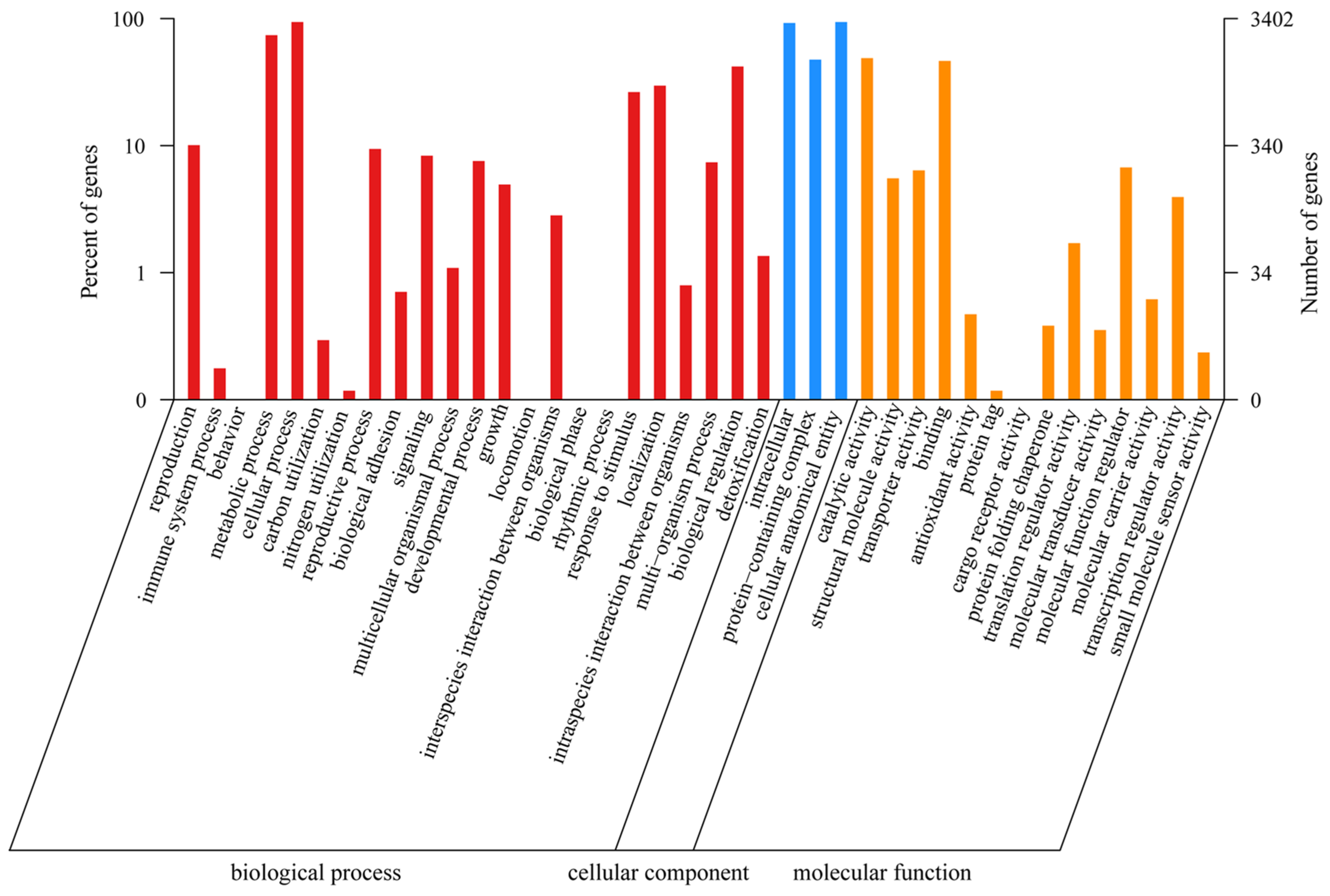
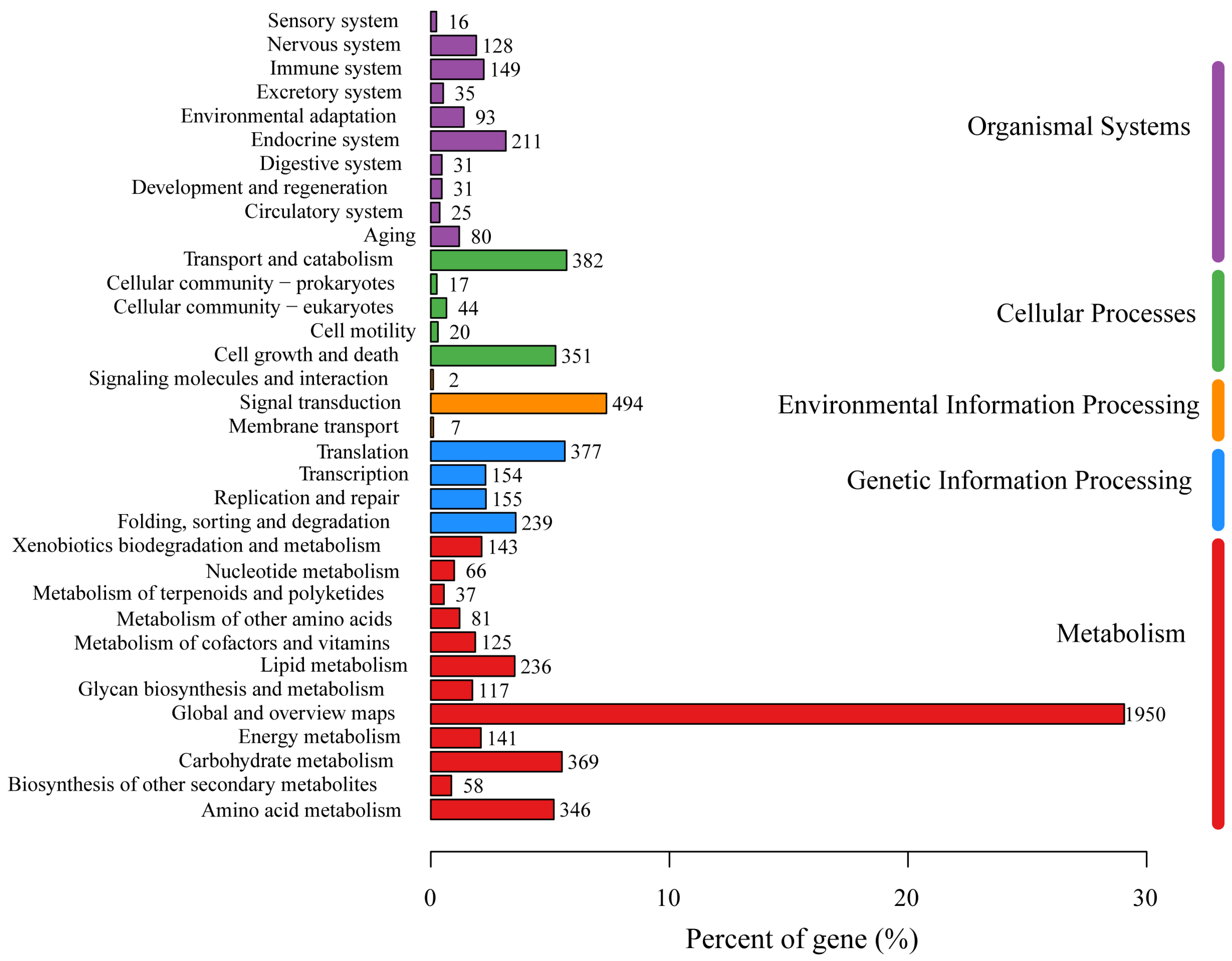
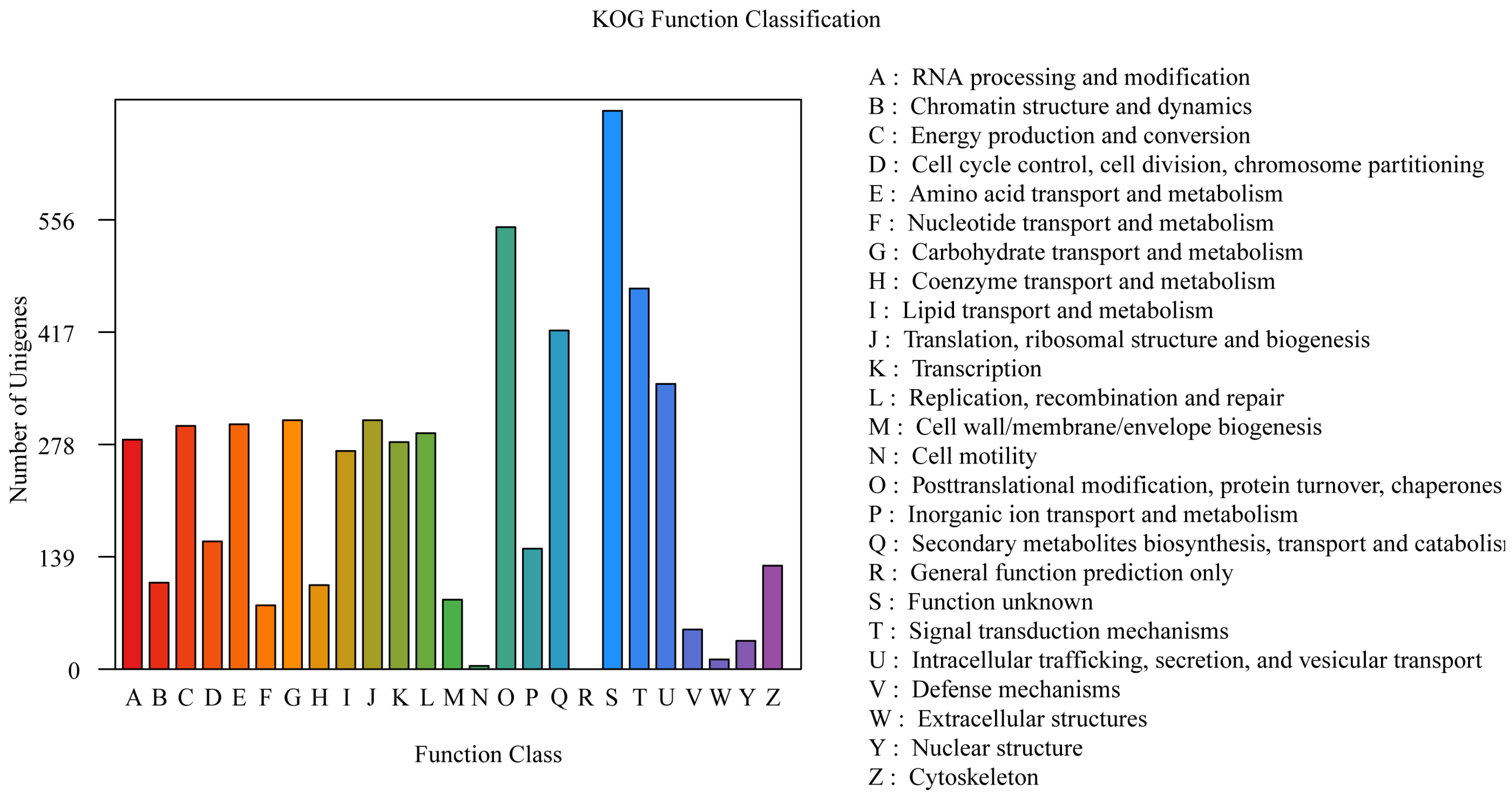



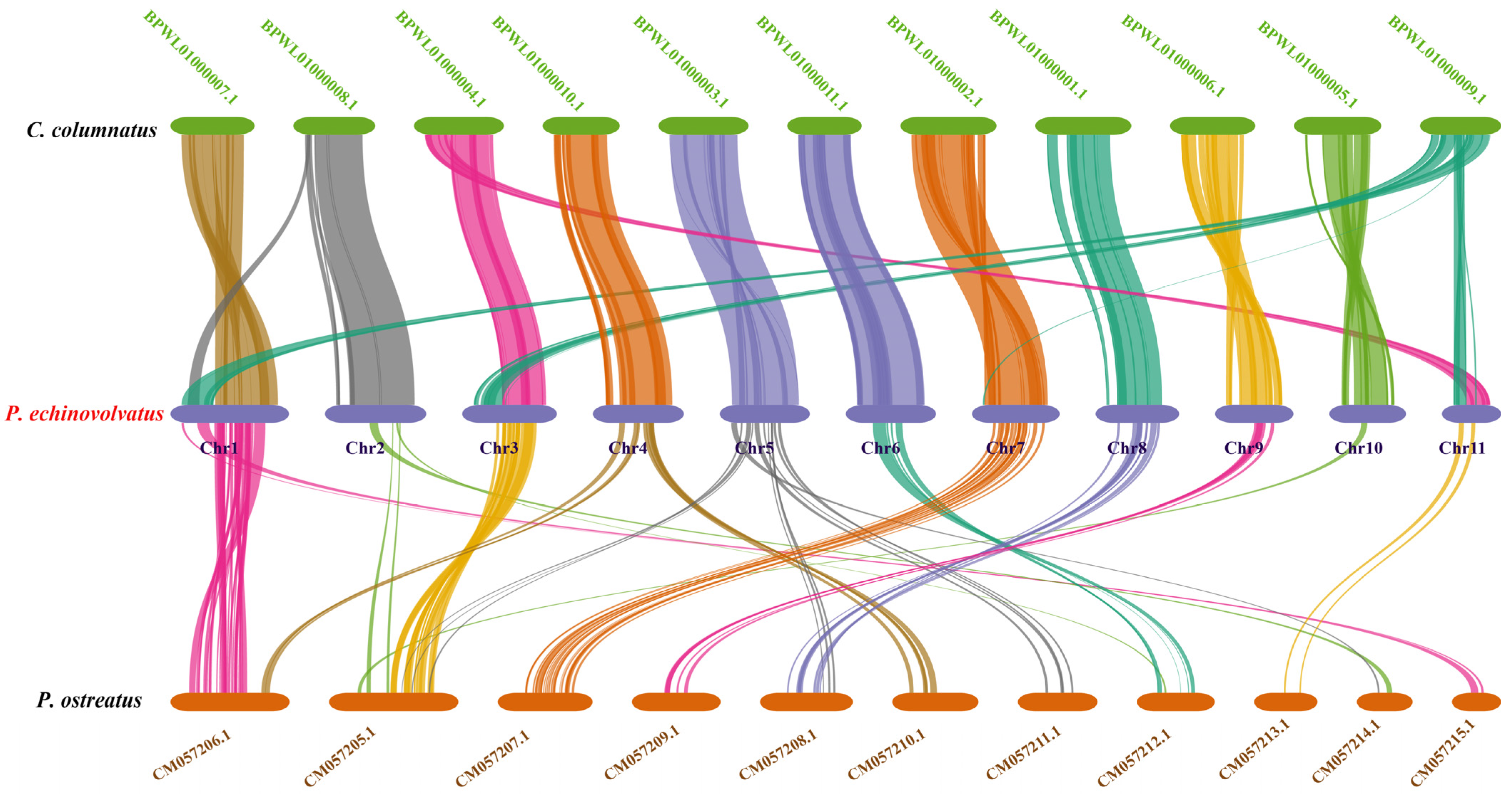

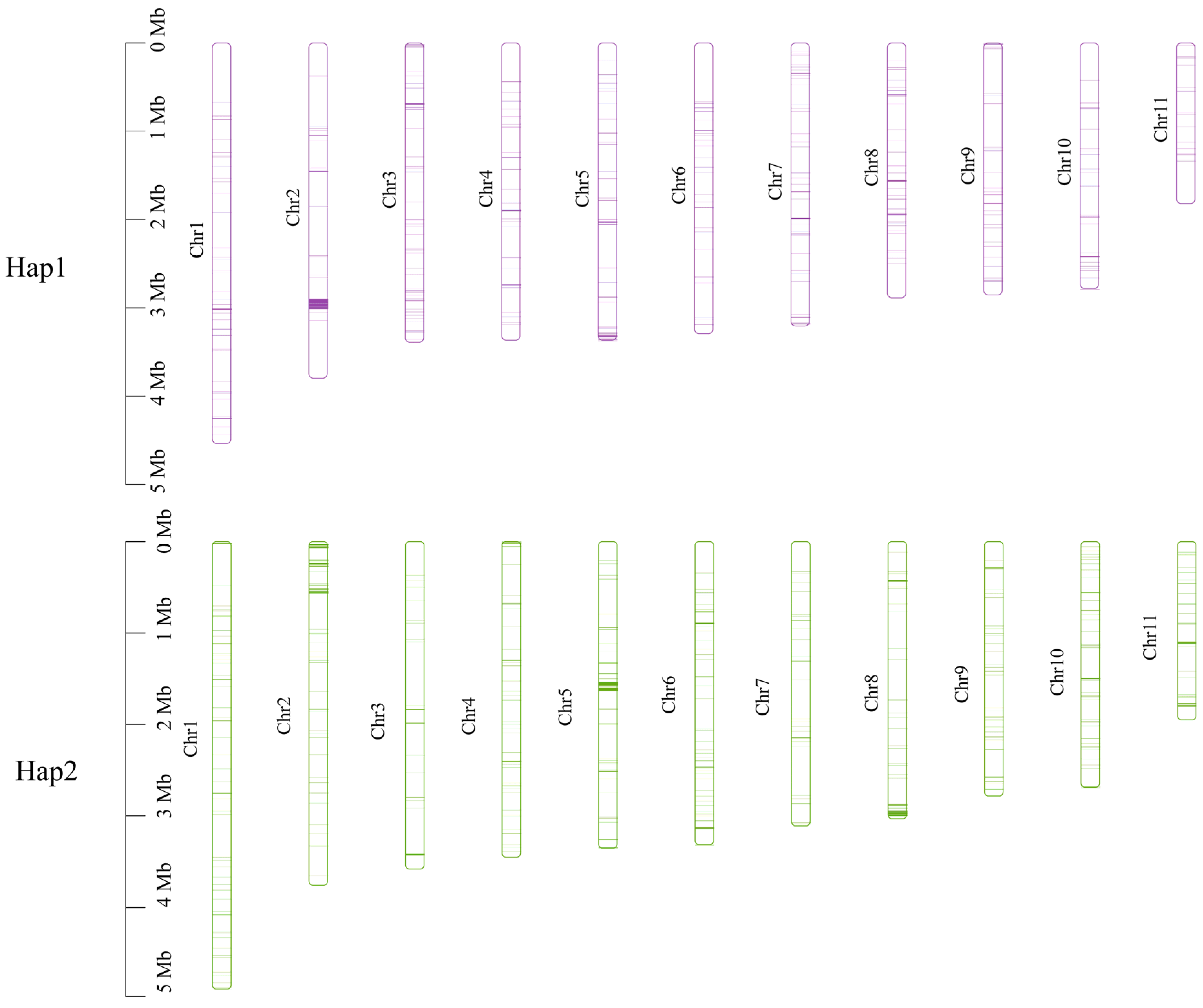
| Contents | Monop | Hap1 | Hap2 | P. rubrovolvatus | P. indusiatus |
|---|---|---|---|---|---|
| Sequencing Technology | Illumina + Hi-C + PacBio HiFi | Illumine + ONT | |||
| Number of Scaffolds | 76 | 183 | 122 | 132 | 216 |
| Total Length (Mb) | 43.85 | 37.68 | 38.46 | 32.89 | 67.32 |
| Scaffold N50 (Mp) | 1.20 | 0.65 | 0.73 | 2.7 | 0.79 |
| Guanine-Cytosine Content (%) | 43.98 | 43.96 | 43.97 | 45.16 | 44.05 |
| Gene Number | 10,251 | 9316 | 9328 | 9725 | 19,909 |
| Gene Total Length (Mb) | 16.21 | 14.83 | 14.78 | 20.76 | 31.87 |
| Gene Average Length (bp) | 1582 | 1592 | 1585 | 2135.07 | 1601 |
| Gene Length/Genome (%) | 37.09 | 39.38 | 38.47 | 63.1 | 47.25 |
| Pseudo-Chromosome | 11 | 11 | 11 | 11 | _ |
| Pseudo-Chromosome Total Length (Mb) | 36.54 | 36.11 | 35.46 | 28.24 | _ |
| Pseudo-Chromosome N50 Length (Mb) | 3.42 | 3.38 | 3.36 | 2.75 | _ |
| Chromosome Anchoring Rate for Contigs (%) | 83.58 | 94.16 | 93.98 | 85.57 | _ |
| Term | Hap1 | Hap2 | Monop | |||
|---|---|---|---|---|---|---|
| BUSCO Number | Percentage | BUSCO Number | Percentage | BUSCO Number | Percentage | |
| Complete BUSCOs | 1687 | 95.6 | 1691 | 95.8 | 1706 | 96.7 |
| Complete and single-copy BUSCOs | 1553 | 88 | 1579 | 89.5 | 1460 | 82.8 |
| Complete and duplicated BUSCOs | 134 | 7.6 | 112 | 6.3 | 246 | 13.9 |
| Fragmented BUSCOs | 13 | 0.7 | 12 | 0.7 | 13 | 0.7 |
| Missing BUSCOs | 64 | 3.7 | 61 | 3.5 | 45 | 2.6 |
| Total BUSCO groups searched | 1764 | 1.0 | 1764 | 1.0 | 1764 | 1.0 |
| ID | Hap1 | Hap2 | ||
|---|---|---|---|---|
| Length (bp) | Gene Number | Length (bp) | Gene Number | |
| Chr1 | 4,557,232 | 1177 | 4,928,922 | 1169 |
| Chr2 | 3,821,430 | 812 | 3,777,475 | 980 |
| Chr3 | 3,400,287 | 844 | 3,601,952 | 766 |
| Chr4 | 3,382,853 | 923 | 3,473,486 | 949 |
| Chr5 | 3,377,001 | 1052 | 3,363,986 | 614 |
| Chr6 | 3,305,313 | 867 | 3,326,919 | 1032 |
| Chr7 | 3,217,999 | 586 | 3,117,068 | 719 |
| Chr8 | 2,906,280 | 763 | 3,049,163 | 783 |
| Chr9 | 2,867,821 | 579 | 2,808,455 | 679 |
| Chr10 | 2,792,080 | 687 | 2,697,050 | 574 |
| Chr11 | 1,831,909 | 454 | 1,961,784 | 465 |
| Total | 35,460,205 | 8744 | 36,106,260 | 8730 |
Disclaimer/Publisher’s Note: The statements, opinions and data contained in all publications are solely those of the individual author(s) and contributor(s) and not of MDPI and/or the editor(s). MDPI and/or the editor(s) disclaim responsibility for any injury to people or property resulting from any ideas, methods, instructions or products referred to in the content. |
© 2025 by the authors. Licensee MDPI, Basel, Switzerland. This article is an open access article distributed under the terms and conditions of the Creative Commons Attribution (CC BY) license (https://creativecommons.org/licenses/by/4.0/).
Share and Cite
An, M.; Liang, R.; Chen, Y.; Zhang, J.; Wang, X.; Li, X.; Qu, G.; Liang, J. Chromosome-Level Genome Assembly and Annotation of the Highly Heterozygous Phallus echinovolvatus Provide New Insights into Its Genetics. J. Fungi 2025, 11, 62. https://doi.org/10.3390/jof11010062
An M, Liang R, Chen Y, Zhang J, Wang X, Li X, Qu G, Liang J. Chromosome-Level Genome Assembly and Annotation of the Highly Heterozygous Phallus echinovolvatus Provide New Insights into Its Genetics. Journal of Fungi. 2025; 11(1):62. https://doi.org/10.3390/jof11010062
Chicago/Turabian StyleAn, Mengya, Ruoxi Liang, Yanliu Chen, Jinhua Zhang, Xiuqing Wang, Xing Li, Guohua Qu, and Junfeng Liang. 2025. "Chromosome-Level Genome Assembly and Annotation of the Highly Heterozygous Phallus echinovolvatus Provide New Insights into Its Genetics" Journal of Fungi 11, no. 1: 62. https://doi.org/10.3390/jof11010062
APA StyleAn, M., Liang, R., Chen, Y., Zhang, J., Wang, X., Li, X., Qu, G., & Liang, J. (2025). Chromosome-Level Genome Assembly and Annotation of the Highly Heterozygous Phallus echinovolvatus Provide New Insights into Its Genetics. Journal of Fungi, 11(1), 62. https://doi.org/10.3390/jof11010062







